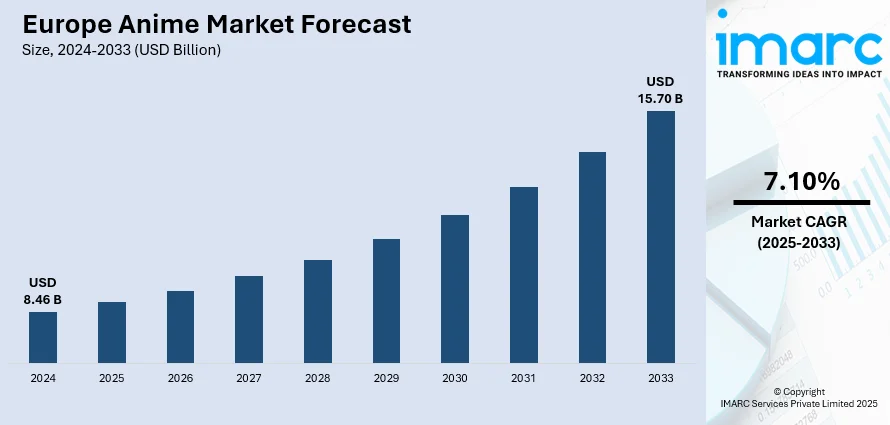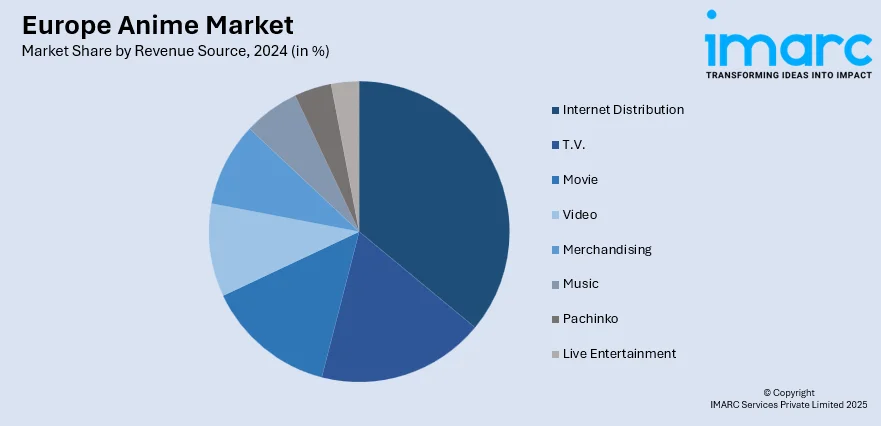
Europe Anime Market Size, Share, Trends and Forecast by Revenue Source, and Country, 2025-2033
Europe Anime Market Size and Share:
The Europe anime market size was valued at USD 8.46 Billion in 2024. Looking forward, IMARC Group estimates the market to reach USD 15.70 Billion by 2033, exhibiting a CAGR of 7.10% during 2025-2033. Germany dominated the market in 2024. The growing fanbase and communities, the rise of digital streaming platforms, increasing localization efforts and subtitling, the rising influence of anime on European media, and the increasing cross-cultural appeal represent some of the key factors contributing to the Europe anime market share.
|
Report Attribute
|
Key Statistics
|
|---|---|
|
Base Year
|
2024 |
|
Forecast Years
|
2025-2033
|
|
Historical Years
|
2019-2024
|
| Market Size in 2024 | USD 8.46 Billion |
| Market Forecast in 2033 | USD 15.70 Billion |
| Market Growth Rate (2025-2033) | 7.10% |
The market is expanding due to growing accessibility through streaming platforms like Netflix and Crunchyroll, which offer subtitled and dubbed content in various European languages. This has widened the audience beyond traditional fans to include younger viewers and mainstream entertainment consumers. Localized licensing, strategic partnerships, and the rise of anime-themed video games also contribute to stronger market penetration. Increasing attendance at anime conventions and the spread of cosplay culture have created robust fan communities across the region. Additionally, merchandise sales, figures, apparel, posters, and more generate significant revenue. Cross-media collaborations with music, fashion, and sports brands have made anime culturally relevant in Europe. Economic growth and higher disposable income in some regions have further supported spending on anime-related products and events, adding to the Europe anime market growth.

To get more information on this market, Request Sample
Distributors are investing more in anime for the big screen, highlighting growing audience interest in theatrical experiences. Classic restorations and new titles are being positioned as cinematic events, signaling that anime is not just for home viewing but increasingly embraced in theaters across European markets. For instance, in January 2025, Piece of Magic Entertainment announced its 2025 anime theatrical slate for Europe, headlined by a 4K restoration of Akira. The lineup also included Dan Da Dan: Evil Eye, Grave of the Fireflies, and Lupin the Third: The Immortal Bloodline, reflecting strong confidence in anime’s cinematic draw across European territories.
Europe Anime Market Trends:
Rising Demand for Multi-Service Access in Anime Streaming
Across Europe, there's a clear shift in how audiences engage with anime content. Viewers are increasingly signing up for multiple streaming platforms rather than sticking to a single service. This growing pattern reflects a desire for broader access, allowing fans to explore a wider range of shows, styles, and genres without restriction. The rise of exclusive titles on various platforms has pushed audiences to diversify their subscriptions, creating a more fragmented but richer viewing environment. Anime enthusiasts are no longer satisfied with limited catalogs. They want flexibility and choice, even if it means juggling several services. This behavior is influencing how content is acquired, distributed, and marketed throughout the region, shaping the Europe anime market outlook. For example, Europe stands out with its high penetration of video subscriptions, as 78% of households own at least one service, with 45% owning three or more.
On-Demand Viewing Reshaping Anime Consumption
In Spain and Italy, interest in anime is becoming increasingly tied to digital convenience. Streaming services are gaining more ground as viewers move away from traditional channels in favor of flexible, anytime access. The boost in income from these platforms reflects a shift toward personalized viewing habits, where fans expect content to be readily available across devices. This behavior is driving licensing priorities and content strategies, with more focus on digital rights and platform partnerships. As per the Europe anime market forecast, the region is adapting to an audience that values control over when and how they watch, making on-demand availability a key factor in the growing popularity of anime across southern Europe. For instance, a recent report shows that streaming income for anime content in Spain and Italy climbed 16 % and 14 %, respectively, over the past year, underscoring how on‑demand access is reshaping consumption habits.
Regional Language Preferences Shaping Anime Localization
Viewer preferences for anime localization vary sharply across regions. In the UK and US, most foreign-language audiences lean toward subtitles, valuing original voice performances and a more authentic experience. By contrast, in Germany, Italy, and France, a majority favor dubbed versions, often due to cultural norms and established dubbing industries. These differences affect how platforms approach content adaptation, influencing everything from licensing to voice casting. Providers targeting multiple European and North American markets are increasingly offering both options to satisfy diverse expectations. Understanding these viewing habits is becoming essential for expanding anime’s reach across language barriers. For example, in the UK and US, over 3 in 4 foreign language viewers prefer content to have subtitles, whereas in Germany, Italy, and France, over half would prefer content to be dubbed.
Europe Anime Industry Segmentation:
IMARC Group provides an analysis of the key trends in each segment of the Europe anime market, along with forecasts at the regional and country levels from 2025-2033. The market has been categorized based on revenue source.
Analysis by Revenue Source:

- T.V.
- Movie
- Video
- Internet Distribution
- Merchandising
- Music
- Pachinko
- Live Entertainment
Internet distribution stood as the largest revenue source in 2024, holding around 23.9% of the market by eliminating the need for traditional TV networks or physical media. Streaming services provide instant access to a wide library of titles, including simulcasts from Japan, which has helped reduce piracy and boost legal viewership. Services like Crunchyroll, Netflix, and Wakanim offer region-specific subtitles and dubs, making anime more accessible to non-Japanese-speaking audiences. The flexibility of on-demand viewing encourages higher engagement, repeat watching, and interest in related products like games, collectibles, and events. As internet access improves, especially in Eastern and Central Europe, these platforms are gaining users in areas that previously had limited exposure to anime. This digital-first approach is drawing investment from global players, reshaping the market by making anime more available, visible, and commercially viable across the region.
Country Analysis:
- Germany
- France
- United Kingdom
- Italy
- Spain
- Others
In 2024, Germany accounted for the largest market share. It has a well-established fan base with a strong interest in Japanese pop culture, supported by anime conventions, merchandise sales, and streaming platforms. German broadcasters have a long history of airing dubbed anime on TV, helping build familiarity and sustained demand. The country also has one of the highest disposable incomes in Europe, which translates into greater spending on entertainment, including anime-related products. Licensing and distribution companies in Germany have been proactive in acquiring rights for popular titles, ensuring timely releases with high-quality dubbing. Furthermore, the availability of anime across multiple platforms, i.e., TV, Blu-ray, cinema, and streaming, has helped broaden access and consumption. These combined factors have positioned Germany as the leading contributor to anime revenue in the European region.
Competitive Landscape:
The anime market in Europe is seeing strong growth, especially through streaming services expanding their catalogs with local language options. Collaborations between Japanese creators and European studios have increased, with co-productions becoming more common. Licensing and merchandising deals are widespread, helping expand anime’s reach beyond digital platforms. Industry groups are actively working across borders to improve support structures, including shared tools and advocacy efforts. Governments are not leading major funding efforts, but there is growing institutional backing through industry associations. Research and development are limited, mostly driven by private studios exploring animation technology. Among all these, streaming partnerships, content localization, and merchandising collaborations are currently the most active Europe anime market trends.
The report provides a comprehensive analysis of the competitive landscape in the Europe anime market with detailed profiles of all major companies.
Latest News and Developments:
- June 2025: Crunchyroll announced its Summer 2025 anime lineup for Europe, featuring premieres like Gachiakuta, Kaiju No. 8 Season 2, DAN DA DAN Season 2, and My Dress-Up Darling Season 2. Returning hits like Dr. STONE and Toilet-bound Hanako-kun also continued, expanding content for anime fans across the region.
- May 2024: Parc Spirou Provence unveiled construction images of Europe’s first Naruto-themed Park zone in France, set for a 2026 launch. Spanning 15,000m², it features a Zamperla rollercoaster and attractions replicating Konoha Village. The project followed major licensing deals, reflecting Naruto’s strong fanbase and growing anime influence across the continent.
- March 2025: Anime Ltd. acquired The Colors Within for European release, with PLAION PICTURES handling German- and Italian-speaking regions. The film, directed by Naoko Yamada and produced by Science SARU, premiered in Japan in August 2024 and featured European distribution plans alongside digital and Blu-ray releases, following its successful North American debut.
- February 2025: Ecoprod and Eurimages unveiled Step Up, a sustainability toolkit and anime platform for European audiovisual professionals. Launched at the EFM, the initiative offered interactive resources and green production training, aiming to promote sustainable filmmaking practices and facilitate knowledge-sharing across international film industries.
Europe Anime Market Report Scope:
| Report Features | Details |
|---|---|
| Base Year of the Analysis | 2024 |
| Historical Period | 2019-2024 |
| Forecast Period | 2025-2033 |
| Units | Billion USD |
| Scope of the Report | Exploration of Historical and Forecast Trends, Industry Catalysts and Challenges, Segment-Wise Historical and Predictive Market Assessment:
|
| Revenue Sources Covered | T.V., Movie, Video, Internet Distribution, Merchandising, Music, Pachinko, Live Entertainment |
| Countries Covered | Germany, France, the United Kingdom, Italy, Spain, Others |
| Customization Scope | 10% Free Customization |
| Post-Sale Analyst Support | 10-12 Weeks |
| Delivery Format | PDF and Excel through Email (We can also provide the editable version of the report in PPT/Word format on special request) |
Key Benefits for Stakeholders:
- IMARC’s report offers a comprehensive quantitative analysis of various market segments, historical and current market trends, market forecasts, and dynamics of the Europe anime market from 2019-2033.
- The research study provides the latest information on the market drivers, challenges, and opportunities in the Europe anime market.
- Porter's five forces analysis assist stakeholders in assessing the impact of new entrants, competitive rivalry, supplier power, buyer power, and the threat of substitution. It helps stakeholders to analyze the level of competition within the Europe anime industry and its attractiveness.
- Competitive landscape allows stakeholders to understand their competitive environment and provides an insight into the current positions of key players in the market.
Key Questions Answered in This Report
The anime market in Europe was valued at USD 8.46 Billion in 2024.
The Europe anime market is projected to exhibit a CAGR of 7.10% during 2025-2033, reaching a value of USD 15.70 Billion by 2033.
Rising anime viewership via streaming platforms, bolstered by multilingual subtitling and dubbing. Strong fan communities and conventions encourage engagement. Merchandise and cross-media collaborations boost revenue. Video-game crossover appeal and cultural diffusion fuel interest. Overall, digital access and fandom-driven ecosystems are powering Europe anime market growth.
Germany accounted for the largest share of the market in 2024 due to high consumer spending on entertainment, strong licensing demand, a large fan base, and widespread availability of dubbed content across T.V. and streaming platforms.
Need more help?
- Speak to our experienced analysts for insights on the current market scenarios.
- Include additional segments and countries to customize the report as per your requirement.
- Gain an unparalleled competitive advantage in your domain by understanding how to utilize the report and positively impacting your operations and revenue.
- For further assistance, please connect with our analysts.
 Request Customization
Request Customization
 Speak to an Analyst
Speak to an Analyst
 Request Brochure
Request Brochure
 Inquire Before Buying
Inquire Before Buying




.webp)




.webp)












